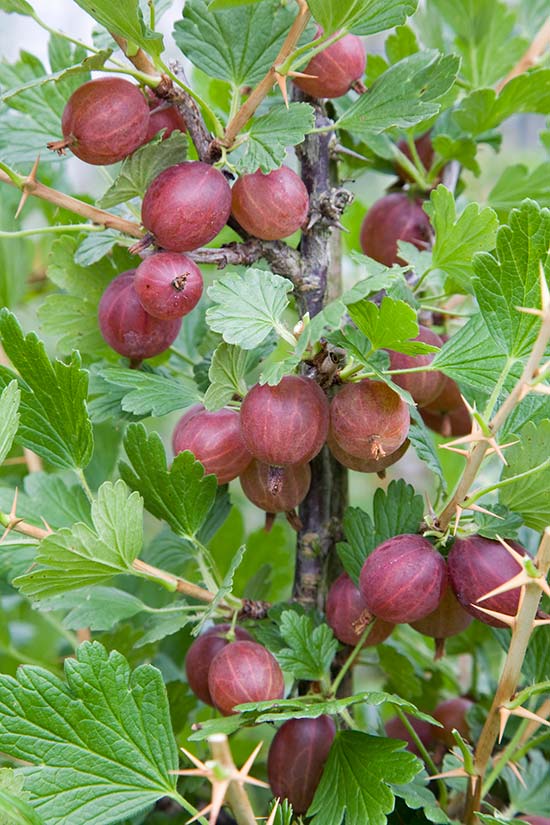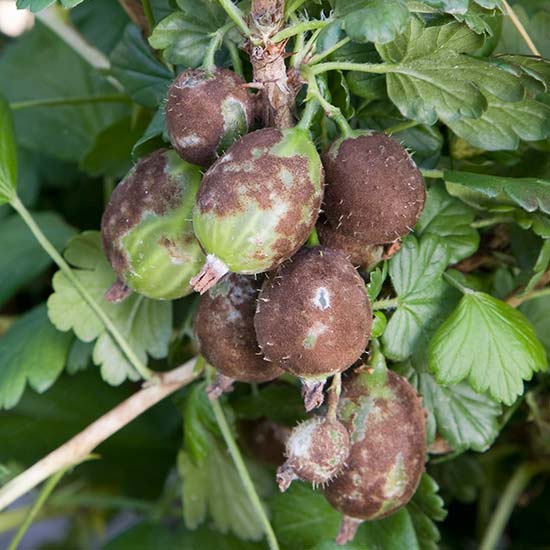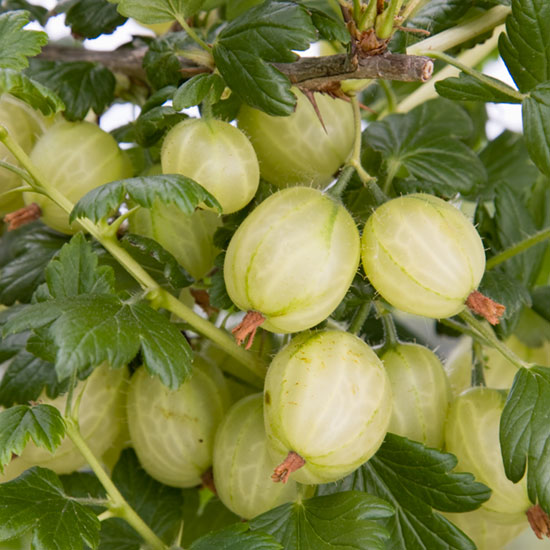In my opinion gooseberries have become a forgotten fruit as I rarely see them grown nowadays. I suppose that in a way I can understand why because most varieties have thorny stems, berries that are regularly covered with mildew and are rarely eaten ripe which means that the intense flavours are missed. But don’t let any of these factors put you off because you can grow gooseberries as cordons so thorny stems aren’t a problem, there are varieties which are resistant to mildew and above all there are varieties which are so luscious when perfectly ripe that you will assume they are exotic fruits! I know that I labour the point a lot about eating soft fruit, in particular, direct from the bush but this is so true about gooseberries – I promise you! Forget those hard bullets that you may be able to find in the shops – grow some large sweet berries in your own garden or allotment.
Although a general perception is that gooseberries are round and green there are many varieties of gooseberry to try, from ones that produce tiny, round, sweet yellow berries to ones that produce large, red and hairy, oval berries. Many of these varieties are fairly resistant or resistant to that mildew problem (which is known as American Gooseberry Mildew) and there are a number of long fruiting varieties which will extend the picking season. There are even some varieties that are solely grown for cooking but frankly I do not recommend growing these unless you are intending to develop a large collection of gooseberries!
The ideal time for planting bare root gooseberries is from late November/early December to late March although if you can get them in before Christmas whilst the soil is still warm so much the better. If you are unable to plant your gooseberries at this time you should be able to find potted plants for planting out at other times of the year. You are ideally looking for a sunny or largely sunny, sheltered site. You need to prepare the ground well removing all weeds, working in a good amount of well-rotted compost and using a good handful of Fruit Feed or blood, fish and bone when planting. When planting out pot grown gooseberries, keep the surface of the rootball level with the surrounding soil level. Space cordons 30-45cm apart (12-18in) apart and bushes at least 1.2m (4ft) apart as this will allow a good circulation of air which will help prevent mildew and give good access for picking. Cordons can be grown as single, double or triple stemmed but I personally prefer the U shaped double cordon. Train them up canes, wires or against a wall and they can often grow up to 1.8m (6ft) in one season. On planting, prune cordon gooseberries back to about 30cm (1ft) above ground level to a bud and for bush gooseberries prune back each branch similarly removing any shoots growing into the middle of the bush.
You may find growing standard gooseberries in pots or containers worthwhile. Use a pot or container at least 35cm (14in) deep and wide and fill with a loam-based compost such as John Innes 3. Although you can easily create your own standard you might find it easier to buy one ready-made.
As far as annual pruning is concerned, the important thing to note is that fruits form on old wood. Using this information each year’s pruning can be planned. If growing cordons, each June prune all new side-shoots back to five leaves to encourage fruiting spurs to develop and tie the leading shoot to the support as it grows. In winter, shorten the previous year’s growth on the main stem leader back by a quarter to encourage new side-shoots. Shorten side-shoots pruned in summer to two or three buds.
If growing your plants as bushes you should use winter pruning to help form a balanced branch structure and keep the centre of the bush open to make picking easier and discourage mildew. As fruits form on old wood and around the base of last year’s growth you should prune back the previous year’s growth to two buds and remove any shoots that are growing into the centre of the bush, and cut back leaders by one-third. Summer pruning isn’t necessarily required, but if time is available prune side-shoots back to five leaves in June. This will allow the sun to reach into the centre of the bush and help ripen the fruit.
During the first year of growth water your gooseberries well and particularly so in times of drought. You will need to net your gooseberries in areas where pigeon populations are large as they seem to have a real liking for these fruits. Recognising that thinning of the berries will have a fairly dramatic effect on the final crop I suggest that you start thinning gooseberries during late May or early June, removing around half the crop, which you can use for cooking. This will enable you to have two useful crops a season and allow the remaining fruits more room to grow to a much larger size. This second crop will not only be of much larger berries but will develop a much sweeter and more intense taste. Of course, you could do what the gooseberry clubs do and grow just a few gooseberries per plant which may often attain the size of a small chicken egg! Make sure that during the ripening and swelling phase of gooseberries they receive plenty of water. However, please note that if you water gooseberries after a drought and not during it you stand a very high chance that the berries will split or burst. When harvesting gooseberries, particularly those grown as bushes, you will need to protect your hands and arms from the aforementioned sharp thorns.
Pests and diseases can be a real nuisance but hopefully managed. The first thing to look out for is gooseberry sawfly which can appear from late spring. This manifests itself as caterpillars which quickly munch their way through foliage. When you find them, squash them! You may find birds such as bullfinches eat the fruit buds as they start developing and can easily strip a plant. If you find this happens to you, netting will be a useful. American Gooseberry Mildew is easily visible and all you can do is remove all affected leaves and berries and hope that it doesn’t spread. You can help prevent this mildew and it’s spread by growing mildew resistant varieties and allowing plenty of air to spread through your plants by keeping the centres of the bushes open.
Varieties
As I noted earlier, there are many varieties of gooseberry of all shapes, sizes and colours. However, some can be quite difficult to grow so if you are only going to grow just two or three varieties you might want to choose any of the following:
Captivator produces large, sweet pinkish-red fruits which are superb eaten fresh. This variety is vigorous, mildew resistant and heavy cropping. Young plants and new shoots have thorns but become virtually thornless once mature.
Careless is a popular variety with pale green fruits that gives heavy yields. It grows well on most soils but can be susceptible to mildew. When thinned berries can grow quite large which makes this an ideal variety for exhibitors.
Greenfinch is an excellent mildew resistant variety that forms quite a compact bush. Produces early yields of bright green fruits that are excellent for cooking from the first picking.
Invicta makes a vigorous and spreading plant that bears large, pale green berries suitable for dessert and culinary use. It gives high yields when grown as a bush or cordon and is largely resistant to mildew.
Hinnonmaki Green is a fairly early green fruited, heavy cropping gooseberry which is largely resistant to mildew. The berries can grow quite large if thinned and are fairly sweet.
Hinnonmaki Red is a mildew resistant gooseberry which is ideal for organic regimes. It will produce heavy crops of medium sized, sweet, red berries.
Hinnonmaki Yellow is a mildew resistant yellow dessert gooseberry, ideal for organic regimes. It produces heavy crops of very large berries with an excellent, aromatic apricot-like flavour.
Leveller is another gooseberry popular with exhibitors as the fruits can grow very large after thinning. The fruits are yellow and develop a very good eating flavour. Unfortunately it is slightly susceptible to mildew
Whinham’s Industry is a popular red-fruited variety, which will grow quite happily in partial shade. It is a good choice for heavy soils but prone to mildew.
Xenia is a modern early ripening red fruited gooseberry which is virtually thornless and resistant to mildew. The large berries can be very sweet and are delicious eaten directly from the bush.
Gerry Edwards
20th May 2015
Gerry is an experienced amateur fruit grower who is Chairman of the RHS Fruit Group, a member of the Royal Horticultural Society’s Fruit, Vegetable and Herb Committee and also their Fruit Trials Panel. Gerry judges fruit nationally for the Royal Horticultural Society and is also a qualified National Vegetable Society judge.




Would it be possible to train a 6 year old hinnonmaki red into a cordon? It is healthy but becoming hemmed in by other fruit bushes which were planted too close and it is difficult to pick the fruit. It is in my fruit cage and I don’t have anywhere to move it to.
I am sure this is possible, though it will obviously take a bit of work. I have never actually done it myself, so others might have slightly different ideas as to how best to achieve it.
Bearing in mind that the normal pruning regime recommended for gooseberries is the regenerative system – remove the lowest stems every winter, feed to encourage new growth up the centre which over the following years will spread out and eventually be removed, this is just a rather more drastic form, and at 6 years old the bush is still relatively young so should adjust to the transition without too much difficulty.
I would suggest you start by getting the stake or bamboo cane in place up which you intend training the cordon. That can be done this coming winter. There is little point doing anything earlier (the ground may be too hard anyway) as the pruning needs to wait until January/February. Then reduce the bush back to a columnar shape by cutting back the lower outward growing branches to short stubs, ultimately leaving just the upward-growing trained stem and side-shoots. This should ideally be done in one go, though if the bush is large (1.2m/4ft + in spread) giving rise to concern that this might give it too much of a shock it could be spread over say 2 years. When cutting back the main side branches try to leave some short spurs of younger growths back near the main stem – the bush will find it a lot easier initially to re-grow from younger buds.
Unfortunately I can see no way of doing this without losing most of at least one year’s crop.
Many thanks for your comprehensive reply. I am going to give it a go it has got to be easier to pick from a cordon than a low cramped bush.